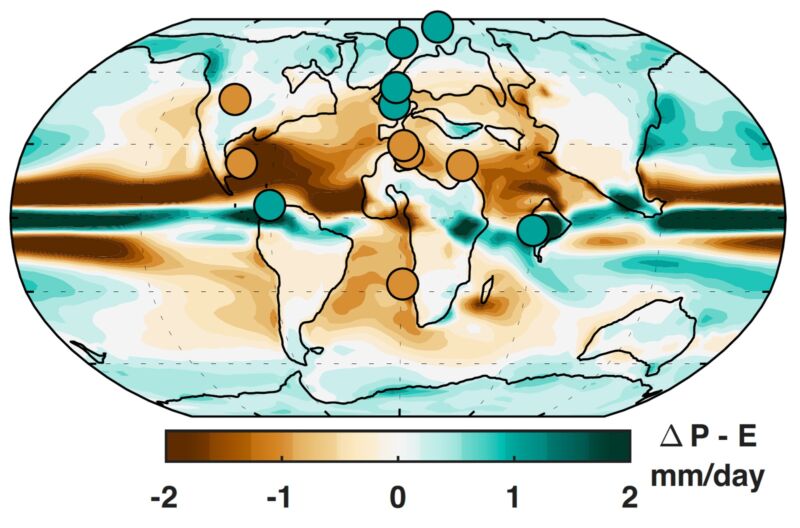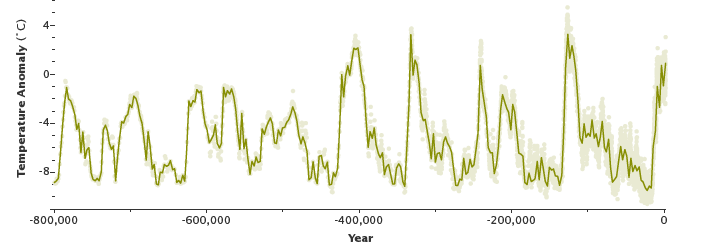
In a study published in PNAS, professor Jessica Tierney of the University of Arizona and colleagues have produced globally complete maps of the carbon-driven warming that occurred in the Paleocene Eocene Thermal Maximum (PETM), 56 million years ago.
While the PETM has some parallels to present warming, the new work includes some unexpected results—the climate response to CO2 then was about twice as strong as the current best estimate by the Intergovernmental Panel on Climate Change (IPCC). But changes in rainfall patterns and the amplification of warming at the poles were remarkably consistent with modern trends, despite being a very different world back then.
A different world
The warming of the PETM was triggered by a geologically rapid release of CO2, primarily from a convulsion of magma in Earth’s mantle at the place where Iceland is now situated. The magma invaded oil-rich sediments in the North Atlantic, boiling off CO2 and methane. It took an already warm, high-CO2 climate and made it hotter for tens of thousands of years, driving some deep-sea creatures and some tropical plants to extinction. Mammals evolved smaller, and there were big migrations across continents; crocodiles, hippo-like creatures, and palm trees all thrived just 500 miles from the North Pole, and Antarctica was ice-free.
As our climate warms, scientists are increasingly looking at past climates for insights, but they are hampered by uncertainties in temperature, CO2 levels, and the exact timing of changes—prior work on the PETM had temperature uncertainties on the order of 8° to 10° C, for example. Now Tierney’s team has narrowed that uncertainty range to just 2.4° C, showing that the PETM warmed by 5.6° C, a refinement on the previous estimate of approximately 5° C.
“We were really able to narrow that estimate down over previous work,” said Tierney.
The researchers also calculated the CO2 levels before and during the PETM derived from isotopes of boron measured in fossil plankton shells. They found CO2 was about 1,120 ppm just before the PETM, rising to 2,020 ppm at its peak. For comparison, preindustrial CO2 was 280 ppm, and we’re currently at about 418 ppm. The team was able to use these new temperature and CO2 values to calculate how much the planet warmed in response to a doubling of CO2 values, or the “Equilibrium Climate Sensitivity” for the PETM.
Highly sensitive
The IPCC’s best estimate for climate sensitivity in our time is 3° C, but that comes with a large uncertainty—it could be anything between 2° to 5° C—due to our imperfect knowledge of feedbacks in the Earth system. If the sensitivity turns out to be on the higher end, then we’ll warm more for a given amount of emissions. Tierney’s study found the PETM climate sensitivity was 6.5° C—more than double the IPCC best estimate.
A higher number is “not too surprising,” Tierney told me, because earlier research had indicated Earth’s response to CO2 is stronger at the higher CO2 levels of Earth’s past. Our climate sensitivity won’t be that high: “We don't expect that we're going to experience a climate sensitivity of 6.5° C tomorrow,” Tierney explained.
Their paper does, however, suggest that if we continue to raise CO2 levels, it will nudge the temperature response to that CO2 higher. “We might expect some level of increased climate sensitivity in the near future, especially if we emit more greenhouse gases,” Tierney said.
Mapping climate by “Data Assimilation”
The new, sharper picture emerges from the way Tierney’s team dealt with geologists’ perennial problem: We don’t have data for every place on the planet. Geological data for the PETM is limited to locations where sediments from that time are preserved and accessible—typically either via a borehole or outcropping on land. Any conclusions about global climate must be scaled up from those sparse data points.
“It's actually a hard problem,” remarked Tierney. “If you want to understand what's happening spatially, it's really hard to do that from just the geological data alone.” So Tierney and colleagues borrowed a technique from weather forecasting. “What weather folks are doing is they're running a weather model, and as the day goes on, they take measurements of wind and temperature, and then they assimilate it into their model … and then run the model again to improve the forecast,” Tierney said.
Instead of thermometers, her team used temperature measurements from the remains of microbes and plankton preserved in 56 million-year-old sediments. Instead of a weather model, they used a climate model that had Eocene geography and no ice sheets to simulate the climate just before, and at the peak of, PETM warmth. They ran the model a bunch of times, varying CO2 levels and Earth’s orbital configuration because of the uncertainties in those. Then they used the microbe and plankton data to select the simulation that best fit the data.
“The idea is really to take advantage of the fact that model simulations are spatially complete. But they are models, so we don't know if they're right. The data know what happened, but they're not spatially complete,” explained Tierney. “So, by blending them, we get the best of both worlds.”
To see how well their blended product matched reality, they checked it against independent data derived from pollen and leaves, and from places not included in the blending process. “They actually matched up really, really well, which is somewhat comforting,” said Tierney.
“The novelty of this study is to use a climate model to rigorously work out what climate state best fits the data both before and during the PETM, giving patterns of climate change all over the globe and a better estimate of global mean temperature change,” said Dr. Tom Dunkley Jones of the University of Birmingham, who was not part of the study.



3175x175(CURRENT).thumb.jpg.b05acc060982b36f5891ba728e6d953c.jpg)

Recommended Comments
There are no comments to display.
Join the conversation
You can post now and register later. If you have an account, sign in now to post with your account.
Note: Your post will require moderator approval before it will be visible.